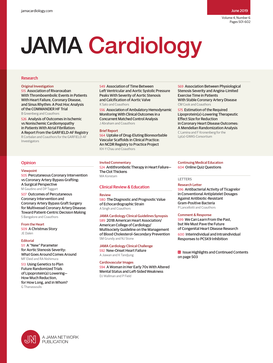保留射血分数的心力衰竭患者采用个性化加速生理性起搏的临床结果
IF 14.1
1区 医学
Q1 CARDIAC & CARDIOVASCULAR SYSTEMS
引用次数: 0
摘要
心脏衰竭患者保留射血分数(HFpEF)和生理性起搏器可能受益于起搏率高于标准60次/分钟(bpm)。目的比较个体化加速起搏与常规护理对HFpEF的不良事件发生情况。设计、环境和参与者:这是myPACE随机临床试验的一项观察性扩展,对100名在佛蒙特大学医学中心接受治疗的B期或C期HFpEF患者进行了长达4年的随访。myPACE研究于2019年6月至2021年12月进行;该报告的后续工作已于2023年6月结束。干预措施最初的myPACE试验的参与者被随机分配到个性化加速起搏(myPACE)或60 bpm(常规护理)。主要结局和措施主要结局是开放标签随访期间首次和复发性不良临床事件的累积-包括因心力衰竭或房颤、心肌梗死、中风或死亡而紧急就诊或住院-使用意向治疗(ITT)分析和预先指定的按方案(PP)分析对继续指定治疗的患者进行评估。次要结局包括ITT和PP分析中的无事件生存期。结果在100名原始试验参与者中(myPACE组48名,常规护理组52名),ITT分析显示myPACE干预有减缓事件发生的趋势(15 vs 33个事件;lin - weii - ying - yang估计[LWYY], 0.48; 95% CI, 0.22-1.06; P = .07)和更长的无事件生存(风险比[HR], 0.63; 95% CI, 0.31-1.29; P = .20),但没有达到统计学意义。在预先指定的PP分析中,87名患者在4年随访期间保持指定的心率设置(myPACE组39名,常规护理组48名)。平均(SD)年龄为74(10)岁,48名参与者(55%)为男性。在这个PP分析中,与常规治疗相比,myPACE与临床事件的缓慢发生(5 vs 31个事件;LWYY, 0.16; 95% CI, 0.04-0.67; P = 0.01)和更长的无事件生存(HR, 0.30; 95% CI, 0.11-0.80; P = 0.02)相关。这些结果主要是由心力衰竭相关事件引起的。结论和相关性在这项myPACE试验的观察性临床事件分析中,ITT分析在研究组之间没有统计学意义。然而,PP分析显示,与标准的60 bpm设置相比,个性化的加速生理性起搏与较慢的不良临床事件累积相关。这些结果是假设产生的,值得在更大的多中心试验中证实。临床试验注册号:NCT04721314本文章由计算机程序翻译,如有差异,请以英文原文为准。
Clinical Outcomes With Personalized Accelerated Physiologic Pacing in Heart Failure With Preserved Ejection Fraction
ImportancePatients with heart failure with preserved ejection fraction (HFpEF) and physiologic pacemakers may benefit from pacing rates above the standard 60 beats per minute (bpm).ObjectiveTo compare adverse event accrual between personalized accelerated pacing and usual care in HFpEF.Design, Setting, and ParticipantsThis was an observational extension of the myPACE randomized clinical trial with up to 4 years of follow-up in 100 patients with stage B or C HFpEF and preexisting physiologic pacemakers treated at the University of Vermont Medical Center. The myPACE study was conducted from June 2019 to December 2021; follow-up for this report was concluded in June 2023.InterventionParticipants in the original myPACE trial were randomly assigned to either personalized accelerated pacing (myPACE) or 60 bpm (usual care).Main Outcomes and MeasuresThe primary outcome was the accrual of first and recurrent adverse clinical events during the open-label follow-up phase—including urgent visits or hospitalizations for heart failure or atrial fibrillation, myocardial infarction, stroke, or death—assessed using an intention-to-treat (ITT) analysis and a prespecified per-protocol (PP) analysis of patients who continued their assigned treatment. Secondary outcomes included event-free survival in both ITT and PP analyses.ResultsAmong the 100 original trial participants (48 in myPACE and 52 in usual care), the ITT analysis demonstrated a trend toward slower event accrual with the myPACE intervention (15 vs 33 events; Lin-Wei-Ying-Yang estimate [LWYY], 0.48; 95% CI, 0.22-1.06; P = .07) and longer event-free survival (hazard ratio [HR], 0.63; 95% CI, 0.31-1.29; P = .20) but did not reach statistical significance. In the prespecified PP analysis, 87 remained on their assigned heart rate setting over the 4-year follow-up (39 in myPACE and 48 in usual care). The mean (SD) age was 74 (10) years, and 48 participants (55%) were male. In this PP analysis, myPACE was associated with a slower accrual of clinical events (5 vs 31 events; LWYY, 0.16; 95% CI, 0.04-0.67; P = .01) and longer event-free survival (HR, 0.30; 95% CI, 0.11-0.80; P = .02) compared to usual care. These results were primarily driven by heart failure–related events.Conclusions and RelevanceIn this observational clinical events analysis of the myPACE trial, analysis by ITT did not achieve statistical significance between study arms. However, PP analysis showed that personalized accelerated physiologic pacing was associated with a slower accrual of adverse clinical events compared with the standard 60-bpm setting. These results are hypothesis generating and warrant confirmation in larger multicenter trials.Trial RegistrationClinicalTrials.gov Identifier: NCT04721314
求助全文
通过发布文献求助,成功后即可免费获取论文全文。
去求助
来源期刊

JAMA cardiology
Medicine-Cardiology and Cardiovascular Medicine
CiteScore
45.80
自引率
1.70%
发文量
264
期刊介绍:
JAMA Cardiology, an international peer-reviewed journal, serves as the premier publication for clinical investigators, clinicians, and trainees in cardiovascular medicine worldwide. As a member of the JAMA Network, it aligns with a consortium of peer-reviewed general medical and specialty publications.
Published online weekly, every Wednesday, and in 12 print/online issues annually, JAMA Cardiology attracts over 4.3 million annual article views and downloads. Research articles become freely accessible online 12 months post-publication without any author fees. Moreover, the online version is readily accessible to institutions in developing countries through the World Health Organization's HINARI program.
Positioned at the intersection of clinical investigation, actionable clinical science, and clinical practice, JAMA Cardiology prioritizes traditional and evolving cardiovascular medicine, alongside evidence-based health policy. It places particular emphasis on health equity, especially when grounded in original science, as a top editorial priority.
 求助内容:
求助内容: 应助结果提醒方式:
应助结果提醒方式:


